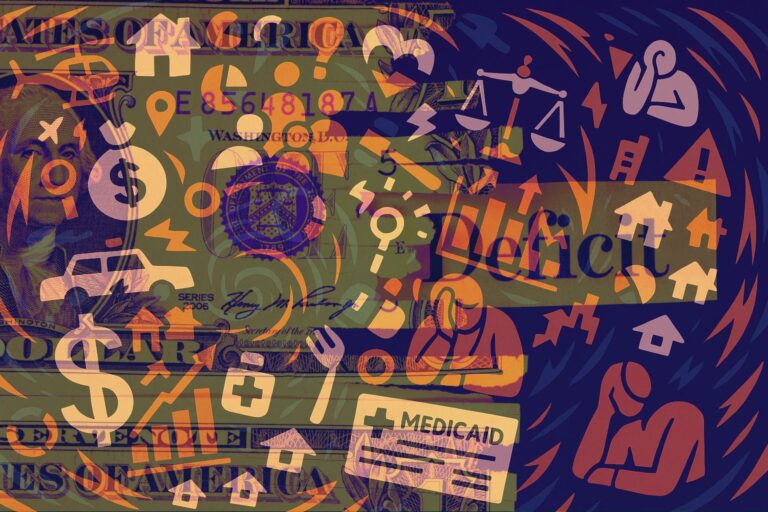Your Health, Your Future—At Risk from Policies That Hurt You and Your Family
A Growing Public Health Crisis, Met with Empty Promises
The United States is facing a growing public health crisis, particularly for children and young people. While not an overnight emergency, long-term trends paint a troubling picture: declining life expectancy, rising chronic disease rates, and a mental health crisis that shows no signs of slowing.
- Life expectancy has declined in recent years, not just due to COVID-19, but also from chronic illnesses, mental health struggles, and widening disparities in healthcare access.
- Childhood obesity rates have tripled since the 1970s, leading to higher risks of diabetes, heart disease, and early mortality.
- Suicide rates among young people have risen nearly 60% in the past decade, yet mental health services remain inaccessible for many.
- Maternal and infant mortality rates are climbing, making pregnancy and early childhood more dangerous in the U.S. than in any other developed nation.
These are real and urgent challenges that demand evidence-based solutions and a commitment to ensuring that children—who do not choose their environment, healthcare access, or food availability—have a fair chance at a healthy future. Addressing these issues requires investment in preventive care, mental health services, and nutrition programs, not just a call for personal responsibility.
The Trump47 administration’s Make America Healthy Again Commission claims to tackle these problems by promoting lifestyle changes, nutrition, and personal accountability. The rhetoric sounds promising. But in practice, the administration has cut funding for healthcare, weakened public health research, and eliminated support for programs that make healthy choices possible.
This is not reform. It is the systematic dismantling of evidence-based healthcare, repackaged as personal empowerment and government accountability.
The Words Sound Great: Promises of Health, Nutrition, and Lifestyle Changes
The Make America Healthy Again Commission presents itself as a bold initiative to improve public health. The administration claims it will combat chronic disease, childhood obesity, and mental health struggles by shifting focus from treatment to prevention. The commission’s messaging emphasizes lifestyle changes, reducing reliance on pharmaceuticals, and restoring transparency in medical research.
At first glance, these priorities seem reasonable. Encouraging healthier eating, increasing physical activity, and preventing disease rather than simply managing it are widely supported ideas. The administration frames this approach as a way to empower individuals, suggesting that better health is within personal control rather than dictated by government or medical institutions.
Among the commission’s stated goals:
- Shifting healthcare toward prevention. The administration argues that chronic diseases such as diabetes, heart disease, and obesity can be avoided through improved nutrition and exercise.
- Promoting personal responsibility. Individuals, rather than healthcare systems or public policies, are presented as the key drivers of health outcomes.
- Reevaluating pharmaceutical use. The commission questions the widespread prescription of antidepressants, ADHD medications, and weight-loss drugs, warning that they may be overused or have long-term risks.
- Advocating for alternative solutions. Wellness farms, re-parenting programs, and other non-medical interventions are highlighted as possible substitutes for traditional treatments.
- Restoring scientific integrity. The administration claims that public health research has been compromised by corporate influence, particularly from pharmaceutical companies, and vows to remove these conflicts of interest.
These ideas, in isolation, are not controversial. Most people would agree that preventing disease is better than treating it, that transparency in research is important, and that a healthier lifestyle can improve long-term well-being. The language of the commission suggests a common-sense approach to fixing a broken system.
But rhetoric is not policy. While the words suggest a commitment to public health, the administration’s actions tell a different story. The next section will examine how these stated goals are undermined by policies that reduce access to healthcare, gut public health research, and dismantle the very systems that support prevention.
The Reality: Health Policy That Works Against Its Own Stated Goals
The Trump47 administration presents the Make America Healthy Again Commission as a solution to America’s growing health challenges. It promotes prevention over treatment, personal responsibility over dependency, and transparency over corruption. But beneath the messaging, the administration’s policies actively undermine these goals.
Rather than strengthening public health, its actions limit healthcare access, cut disease research, weaken mental health services, and make healthy lifestyles harder to achieve. The commission claims to focus on prevention, yet the very programs that enable prevention—regular doctor visits, early screenings, and public health research—are being gutted.
Rolling Back Nutrition and Food Security Programs
Good nutrition is essential to disease prevention, yet the administration has made it harder for families—particularly low-income households—to access healthy food.
- Funding for WIC (Women, Infants, and Children) and SNAP (food assistance) has been reduced, even as food insecurity remains a serious issue in many communities.
- School meal nutrition standards have been rolled back, allowing more processed foods, refined sugars, and high-fat meals back into cafeterias.
- Public awareness campaigns about childhood obesity and healthy eating have been defunded. Without education and access, families have fewer tools to make informed dietary choices.
The commission speaks of personal responsibility and lifestyle changes, yet it is removing the very programs that help families make healthier choices. A child cannot be responsible for their own nutrition when the food available to them is determined by policy decisions that make healthy eating less accessible.
Cuts to Medicaid and Healthcare Access
Preventing disease starts with access to healthcare, yet the administration has slashed Medicaid funding, stripping millions of low-income families—especially children—of essential medical services. Preventive care, such as checkups, vaccinations, and early screenings for obesity and diabetes, is increasingly out of reach for those who rely on government assistance.
- Children’s Health Insurance Program (CHIP) funding has been reduced, limiting coverage for millions of children whose families earn too much to qualify for Medicaid but too little to afford private insurance.
- Federally funded community health clinics have lost support, reducing access to preventive care and early intervention for chronic diseases, particularly in rural and underserved areas.
- Maternal health programs within CHIP and Medicaid have faced funding reductions, restricting essential services for mothers and worsening maternal and infant mortality rates at a time when these outcomes are already declining.
If the commission were truly committed to prevention, it would strengthen Medicaid and CHIP, not restrict them. Children cannot take “personal responsibility” for their healthcare when their access to doctors and medicine is determined by policy decisions far beyond their control.
Defunding Disease Research and Public Health Monitoring
A core tenet of the commission is “scientific integrity,” but its policies suggest a different priority.
- The National Institutes of Health (NIH) budget has been slashed, limiting research into chronic diseases, mental health, and long-term health trends.
- The Centers for Disease Control and Prevention (CDC) has lost funding for tracking childhood obesity, diabetes, and mental health trends. Without reliable data, it is harder to develop effective public health interventions.
- Federal health agencies have removed public access to key health data. Transparency in research is being replaced with selective reporting, making it difficult to assess long-term health outcomes.
A serious commitment to public health requires investment in research, not its suppression. If the administration is genuinely concerned about the overuse of certain pharmaceuticals, research should be expanded to explore both risks and alternatives—not cut entirely.
Undermining Mental Health Care While Criticizing Psychiatric Medications
The commission has positioned itself as a watchdog against the overuse of psychiatric drugs, especially antidepressants, ADHD medications, and weight-loss drugs. The argument is that these medications are overprescribed and have long-term effects that have not been fully studied. While these are valid concerns, the administration’s response has been to restrict mental health services rather than provide meaningful alternatives.
- Funding for mental health clinics and counseling programs has been reduced, leaving fewer options for those seeking therapy or early intervention.
- The push for “wellness farms” and “re-parenting” lacks scientific backing and does not scale to meet the needs of millions of Americans facing serious mental health challenges.
- Workforce reductions in public health agencies have removed professionals dedicated to mental health services.
If the administration were truly committed to mental health, it would expand access to therapy, improve counseling services in schools, and fund research into both pharmaceutical and non-pharmaceutical treatments. Instead, it has chosen to attack medication use while limiting all other forms of care.
A Policy Approach That Contradicts Itself
The commission claims to:
- Prioritize prevention over treatment, yet it is cutting the very services that enable early intervention.
- Ensure scientific integrity, yet it is removing public health data and defunding research.
- Promote healthier lifestyles, yet it is making nutrition and healthcare harder to access.
- Reduce dependence on pharmaceuticals, yet it is not expanding alternative mental health treatments or providing meaningful options for those in need.
If the administration’s goal were truly to improve health outcomes, its policies would reflect that. Instead, they are designed to shift responsibility away from public health institutions and onto individuals—particularly children—who do not have the ability to change their circumstances alone.
The Gutting of Research: Censorship Disguised as “Transparency”
The Make America Healthy Again Commission frames its mission as a fight for scientific integrity. It claims that public health research has been compromised by corporate influence, particularly from pharmaceutical companies, and that medical guidelines have been shaped by profit motives rather than independent science. The administration has vowed to eliminate conflicts of interest, restore transparency, and ensure that research is conducted without outside influence.
At face value, these ideas may seem like a reasonable step toward improving public trust in healthcare. Scientific research should be objective, transparent, and free from undue corporate influence. However, the administration’s approach does not strengthen science—it weakens it. Instead of increasing transparency, it has taken steps to restrict public access to research, reduce funding for critical studies, and dismantle the institutions that provide evidence-based health guidance.
Cuts to Public Health Research
The administration has significantly reduced funding for key federal research programs, making it harder to track and understand long-term health trends. These cuts affect not only disease prevention efforts but also the ability to assess the effectiveness and risks of various treatments.
- The National Institutes of Health (NIH) has faced deep budget reductions, limiting research on chronic diseases, mental health, and nutrition.
- The Centers for Disease Control and Prevention (CDC) has lost funding for tracking obesity, diabetes, and mental health disorders. These are the very conditions the administration claims to be addressing through lifestyle and prevention strategies.
- Independent health research grants have been cut, reducing opportunities for universities and medical institutions to conduct studies free from industry influence.
Without proper funding, research into disease prevention, childhood development, and public health interventions slows. This not only weakens future policy decisions but also leaves gaps in understanding the very issues the commission claims to prioritize.
Restricting Access to Public Health Data
One of the most concerning trends under this administration has been the removal of public health data from federal websites. Previously, government agencies made large amounts of health-related data available to researchers, policymakers, and the public, allowing for independent analysis and accountability. That information is now disappearing.
- Key CDC reports on chronic disease trends have been archived or removed, limiting access to statistics on obesity, diabetes, and mental health.
- Annual health risk assessments, once publicly available, are now restricted or delayed, making it harder for researchers to identify patterns in disease outbreaks or health inequities.
- Environmental health research has been deprioritized, despite growing evidence linking pollution and chemical exposure to chronic illness.
By restricting access to data, the administration is not making research more transparent—it is making it harder to scrutinize. This shift gives the government greater control over what information is released while limiting the ability of independent researchers to verify findings.
Shaping the Narrative Through Selective Investigations
While defunding broad-based medical research, the administration has prioritized investigations into specific areas that align with its political agenda. The commission’s focus on psychiatric medications, weight-loss drugs, and vaccine research is not rooted in a neutral scientific inquiry, but rather in a preconceived distrust of modern medicine.
- The commission is questioning the safety and effectiveness of SSRIs, ADHD medications, and mood stabilizers but is not funding large-scale studies to offer alternative treatments.
- Weight-loss medications are being reviewed for their long-term effects, yet funding for nutrition research and obesity prevention programs has been cut.
- Vaccine studies are being re-examined under the guise of “safety reviews,” despite decades of overwhelming evidence supporting their effectiveness.
These selective investigations are not designed to improve medical knowledge. Instead, they are a means to validate the administration’s existing biases while undermining public trust in long-established health recommendations.
Weakening Oversight of Scientific Integrity
If the administration’s goal were truly to ensure research was independent and free from industry influence, it would strengthen oversight mechanisms, not weaken them. Instead, it has taken steps that reduce the accountability of federal research agencies.
- Many Inspectors general, including those who provide independent oversight of government health agencies, have been dismissed or sidelined.
- Ethics committees have been restructured, with appointments favoring individuals with strong ideological views rather than neutral scientific backgrounds.
- Peer review processes for government-funded studies have been altered, making it easier to approve research that aligns with political goals while sidelining findings that contradict them.
Instead of making science more reliable, these changes open the door to politically motivated research that lacks rigorous oversight. When independent watchdogs are removed, it becomes harder to distinguish credible studies from those shaped by ideology.
The Long-Term Impact of a Weakened Research Infrastructure
Gutting medical research will not just affect policy decisions today—it will have consequences for years to come. A lack of funding and oversight will slow the development of new treatments, limit public health interventions, and create blind spots in understanding future health risks.
- Without research into chronic disease prevention, future generations may face even higher rates of obesity, diabetes, and heart disease.
- Without mental health studies, treatment options will remain stagnant, leaving millions without effective care.
- Without access to public health data, independent researchers and doctors will have fewer tools to make informed decisions.
This is not a move toward scientific integrity. It is an effort to control the public health narrative while dismantling the research institutions that have guided health policy for decades. The administration is not ensuring medical studies are free from corporate influence—it is ensuring they are shaped by political influence instead.
Conclusion: The Illusion of Reform
The Make America Healthy Again Commission presents itself as a transformative effort to improve public health. It claims to promote prevention over treatment, individual responsibility over dependence, and transparency over corruption. But when examined closely, these promises do not hold up.
The administration speaks of better health outcomes, yet its policies make healthcare harder to access. It talks about scientific integrity, yet it is cutting funding for research and limiting public access to data. It calls for reducing reliance on pharmaceuticals, yet it does not expand alternative treatments or improve access to mental health services.
A true reform effort would:
- Expand access to preventive healthcare, not cut Medicaid and CHIP.
- Invest in public health research, not dismantle the institutions that conduct it.
- Improve nutrition access, not reduce food assistance programs and weaken school meal standards.
- Strengthen mental health care, not attack medication use while eliminating therapy and counseling options.
If the administration genuinely believed in personal responsibility as the foundation of better health, it would ensure that people—especially children—have the tools they need to succeed. A child cannot choose to eat healthier if their school lunches are filled with processed foods. A family cannot take responsibility for medical decisions if they lose their insurance. A person struggling with depression cannot make informed choices if therapy is out of reach and medication is demonized.
By shifting responsibility entirely onto individuals while removing the infrastructure that allows for healthier choices, the The administration’s policy changes create greater disparities in health access, disproportionately affecting lower-income families. This is not about reform—it is about shifting blame.
For all its rhetoric about fixing a broken system, the administration is not solving problems, instead worsening them. The words may sound good, but the actions tell the real story.
Sources Include
- Establishing the President’s Make America Healthy Again Commission – https://www.whitehouse.gov/presidential-actions/2025/02/establishing-the-presidents-make-america-healthy-again-commission/
- Fact Sheet: President Donald J. Trump Establishes the Make America Healthy Again Commission – https://www.whitehouse.gov/fact-sheets/2025/02/fact-sheet-president-donald-j-trump-establishes-the-make-america-healthy-again-commission/
- Trump Endorses Budget That Would Slash Medicaid Funding – https://www.ajmc.com/view/trump-endorses-budget-that-would-slash-medicaid-funding
- How Would Children Fare Under Proposed Cuts to Federal Spending? – https://www.urban.org/urban-wire/how-would-children-fare-under-proposed-cuts-federal-spending
- Trump Freezes Federal Grants, Including Those for Medicaid Providers – https://www.healthcaredive.com/news/trump-freezes-federal-grants-healthcare-medicaid-providers/738449/
- Trump Executive Orders Reshape NIH With Major Budget Cuts – https://www.theguardian.com/us-news/2025/feb/20/nih-trump-executive-orders
- Federal Workforce Reductions Under Department of Government Efficiency (DOGE) – https://www.politico.com/news/2025/02/20/gop-lawmaker-doge-cut-panic-00205282
- Trump Signs Executive Order Expanding Access to In Vitro Fertilization – https://www.houstonchronicle.com/health/article/trump-ivf-cost-executive-order-texas-20178116.php
- Trump’s First Month: Actions on Abortion and Reproductive Rights – https://time.com/7260062/trump-first-month-abortion-reproductive-rights/
- This Spending Fight Is Actually About the Constitution – https://www.wsj.com/politics/policy/this-spending-fight-is-actually-about-the-constitution-0658486d
- Kennedy’s Broad Health Agenda Faces Off With Trump’s Budget Cuts – https://www.reuters.com/business/healthcare-pharmaceuticals/kennedys-broad-health-agenda-faces-off-with-trumps-cuts-2025-02-14/
- 6 Big Problems Congress Republicans Face in Implementing Trump’s Agenda – https://nymag.com/intelligencer/article/6-big-problems-congress-republicans-trump-agenda.html
- Proposed Cuts to SNAP and Child Nutrition Programs – https://frac.org/news/proposedcutssnapchildnutritionfeb2025
- Trump Freezes Federal Aid, Creating Uncertainty for Nutrition Programs – https://www.politico.com/news/2025/01/27/trump-freezes-federal-aid-omb-00200891
- White House Clarifies Nutrition Programs Are Unaffected by Trump Funding Freeze – https://www.reuters.com/world/us/nutrition-programs-unaffected-by-trump-funding-freeze-white-house-says-2025-01-28/
- USDA Vows to Correct “Biden’s Financial Mismanagement” of SNAP – https://www.usda.gov/about-usda/news/press-releases/2025/02/12/trump-usda-vows-correct-bidens-financial-mismanagement-snap
- U.S. Life Expectancy Decline Due to Chronic Disease, Mental Health Struggles, and Healthcare Disparities – https://mcpress.mayoclinic.org/healthy-aging/whats-behind-the-decline-in-american-life-expectancy/
- Childhood Obesity Rates Have Tripled Since the 1970s – https://pmc.ncbi.nlm.nih.gov/articles/PMC6887808/
- Youth Suicide Rates Have Risen Nearly 60% Over the Past Decade – https://publichealth.jhu.edu/2022/life-expectancy-is-declining-in-the-us
- Maternal and Infant Mortality Rates Are Rising in the U.S. – https://www.theguardian.com/world/2024/sep/25/abortion-bans-healthcare-maternal-mortality







